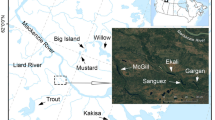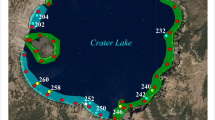Abstract
We assessed the long-term (16 years) effects of introducing piscivores (northern pike) into a small, boreal lake (Lake 221, Experimental Lakes Area) containing abundant populations of two planktivorous fish species. After the introduction, pearl dace were extirpated and yellow perch abundance was greatly reduced. Daphnia species shifted from D. galeata mendota to larger bodied Daphnia catawba, but the total zooplankton biomass did not increase, nor did the biomass of large grazers such as Daphnia. Phytoplankton biomass decreased after the northern pike introduction, but increased when northern pike were partially removed from the lake. Phosphorus (P) excretion by fish was ∼0.18 mg P m−2 d−1 before pike addition, declined rapidly to approximately 0.03–0.10 as planktivorous perch and dace populations were reduced by pike, and increased back to premanipulation levels after the pike were partially removed and the perch population recovered. When perch were abundant, P excretion by fish supported about 30% of the P demand by primary producers, decreasing to 6–14% when pike were abundant. Changes in phytoplankton abundance in Lake 221 appear to be driven by changes in P cycling by yellow perch, whose abundance was controlled by the addition and removal of pike. These results confirm the role of nutrient cycling in mediating trophic cascades and are consistent with previous enclosure experiments conducted in the same lake.






Similar content being viewed by others
References
Attayde JL, Hansson LA. 1999. Effects of nutrient recycling by zooplankton and fish on phytoplankton communities. Oecologia 121:47–54
Attayde JL, Hansson LA. 2001. The relative importance of fish predation and excretion effects on planktonic communities. Limnol Oceanogr 46:1001–1012
Bagenal TB, Tesch FW. 1978. Age and growth. In: Bagenal TB, Eds. Methods for assessment of fish production in freshwater, 3rd ed. Oxford: Blackwell Scientific Publications. p 101–103
Beamish RJ, Blouw LM, McFarlane GAA. 1976. Fish and chemical study of 109 lakes in the experimental lakes area, northwestern Ontario, with appended reports on lake whitefish ageing errors and the northwestern Ontario baitfish industry. Canadian Fisheries and Marine Service Technical Report 607: p116
Benndorf J. 1987. Food web manipulation without nutrient control: a useful strategy in lake restoration? Schweizerische Zeitschrift für Hydrologie 49:239–248
Benndorf J. 1995. Possibilities and limitations for controlling eutrophication by biomanipulation. Internationale Revue der Gestamten Hydrobiologie. 80:519–34
Benndorf J, Böing W, Koop J, Neubauer I. 2002. Top-down control of phytoplankton: the role of time scale, lake depth and trophic state. Freshw Biol 47:2282–95
Benndorf J, Kneschke H, Kossatz K, Penz E. 1984. Manipulation of the pelagic food web by stocking with predacious fishes. Internationale Revue der Gestamten Hydrobiologie 69:407–28
Brabrand A, Faafeng BA, Nilssen JPM. 1990. Relative importance of phosphorus supply to phytoplankton production: fish excretion versus external loading. Can J of Fish Aqua Sci 47:364–72
Carpenter SR, Kitchell JF, Bade D, Essington TE, Houser JN, Cole JJ, Pace ML, Hodgson JR, Cottingham KL, Schindler DE. 2001. Trophic cascades, nutrients, and lake productivity: Whole-lake experiments. Ecol Monogr 71:163–86
Carpenter SR, Kitchell JF, Hodgson JR. 1985. Cascading trophic interactions and lake ecosystem productivity. BioScience 35:635–639
Carpenter SR, Kraft CE, Wright R, He X, Soranno PA, Hodgson RJ. 1992. Resilience and resistance of a lake phosphorus cycle before and after food web manipulation. Am Nat 140:781–98
DeMelo R, France R, McQueen DJ. 1992. Biomanipulation. Hit or myth? Limnol Oceanogr 37:192–207
Drenner RW, Hambright KD. 1999. Review: Biomanipulation of fish assemblages as a lake restoration technique. Archiv für Hydrobiologie.164:129–165
Eddy JB. 2000. Estimation of the abundance, biomass, and growth of a northwestern Ontario population of finescale dace (Phoxinus neogaeus), with comments on the sustainability of local commercial baitfish harvests. Master natural resource management thesis. Winnipeg: University of Manitoba. 85 p
Elser JJ, Elser MM, MacKay NA, Carpenter SR. 1988. Zooplankton-mediated transitions between N and P limited algal growth. Limnol Oceanogr 33:1–14
Fee EJ, Hecky RE, Kasian SEM, Cruikshank DR. 1996. Effects of lake size, water clarity, and climatic variability on mixing depths in Canadian Shield lakes. Limnol Oceanogr 5:912–20
Findlay DL, Kasian SEM, Hendzel LL, Regehr G, Schindler EU, Shearer JA. 1994. Biomanipulation of Lake 221 in the experimental lakes area (ELA): effects on phytoplankton and nutrients. Can J of Fish Aquat Sci 51:2794–807
Findlay DL, Kasian SEM, Stainton MP, Beaty K, Lyng M. 2001. Climatic influences on algal populations of boreal forest lakes in the experimental lakes area. Limnol Oceanogr 46:1784–1793
Hairston NG, Smith FE, Slobodkin LB. 1960. Community structure, population control, and competition. Am Nat 94:421–425
Hecky RE, Campbell P, Hendzel LL. 1993. The stoichiometry of carbon, nitrogen, and phosphorus in particulate matter of lakes and oceans. Limnol Oceanogr 38:709–724
Hill MO. 1979. Decorana: a FORTRAN program for detrended correspondence analysis and reciprocal averaging. Ecology and Systematics. Ithaca (NY): Cornell University
Jeppesen E, Jensen JP, Søndergaard M, Lauridsen T. 1999. Trophic dynamics in turbid and clearwater lakes with special emphasis on the role of zooplankton for water clarity. Hydrobiologia 408/409:217–231
Jeppesen E, Jensen JP, Søndergaard M, Lauridsen T, Landkildehus F. 2000. Trophic structure, species richness and biodiversity in Danish lakes: changes along a phosphorus gradient. Freshw Biol 45:201–218
Kasprzak P, Benndorf J, Mehner T, Koschel R. 2002. Biomanipulation of lake ecosystems: an introduction. Freshw Biol 47:2277–81
Lawrence SG, Malley DF, Findlay WJ, MacIver MA, Delbaere IL. 1987. Method for estimating dry weight of freshwater planktonic crustaceans from measures of length and shape. Can J of Fish Aqua Sci 44:264–274
Malley DF, Lawrence SG, MacIver MA, Findlay WJ. 1989. Range of variation in estimates of dry weight for planktonic Crustacea and Rotifera from temperate North American lakes. Canadian Technical Report of Fisheries and Aquatic Sciences: 1666. 49 p. Winnipeg: Department of Fisheries & Oceans
McQueen DJ, Johannes MRS, Post JR, Stewart TJ, Lean DS. 1989. Bottom-up and top-down impacts on freshwater pelagic community structure. Ecol Monogr 59:289–309
Mills KH, Chalanchuk SM, Mohr LC, Davies IJ. 1987. Responses of fish populations in lake 223 to 8 years of experimental acidification. Can J Fish and Aquat Sci 44:114–125
Nauwerck A. 1963. Die Beziehungen zwischen Zooplankton und Phytoplankton in See Erken. Syme Bot Upsaliensis 17:1–163
Noonan TA. 1998. Como Lake, Minnesota: the long-term response of a shallow urban lake to biomanipulation. J Lake Reservoir Manage 14(1):92–109
Porter KG, Feig YS. 1980. The use of DAPI for identifying and counting aquatic microflora. Limnol Oceanogr 25:943–8
Reynolds CS. 1994. Invited review: the ecological basis foe the successful biomanipulation of aquatic communities. Archiv für Hydrobiologie 130:1–33
Rott E. 1981. Some results from phytoplankton counting intercalibrations. Hydrobiologia 43:43–62
Rusak JA, Yan ND, Somers KM, Cottingham KL, Micheli F, Carpenter SR, Frost TM, Paterson MJ, McQueen DJ. 2002. Temporal, spatial, and taxonomic patterns of crustacean zooplankton variability in unmanipulated north-temperate lakes. Limnol Oceanogr 3:613–25
SAS Institute Inc. 1990. SAS user’s guide; statistics. Version 5 ed. Cary, (NC): SAS Institute Inc
Schaus MH, Vanni MJ, Wissing TE, Bremigan MT, Garvey JE, Stein RA. 1997. Nitrogen and phosphorus excretion by detritivorous gizzard shad in a reservoir ecosystem. Limnol Oceanogr 42:1386–1397
Schindler DE, Eby LA. 1997. Stoichiometry of fishes and their prey: implications for nutrient recycling. Ecology 78:1816–31
Schindler DE, Kitchell JF, He X, Carpenter SR, Hodgson JR, Cottingham KL. 1993. Food web structure and phosphorus cycling in lakes. Trans Am Fish Soc 122:756–772
Schindler DW, Hesslein RH, Turner MA. 1987. Exchange of nutrients between sediments and water after 15 years of experimental eutrophication. Can J of Fish and Aquat Sci 44:26–33
Schindler DW, Noven B. 1971. Vertical distribution and seasonal abundance of zooplankton in two shallow lakes of the experimental lakes area, northwestern Ontario. J Fish Res Board Can 28:245–256
Seber GAF. 1982. The estimation of animal abundance and related parameters. 2nd ed. NY: MacMillan Publishing. 654 p
Shapiro J, Lamarra V, Lynch M. 1975. Biomanipulation: an ecosystem approach to lake restoration. In: Brezonik PL, Fox JL, Ed. Proceedings of a Symposium on Water Quality Management Through Biological Control. Washington (DC): U.S. Environmental Protection Agency. p 85–96
Shearer JA. 1978. Two devices for obtaining water samples integrated over depth. Canadian Fisheries and Marine Services Technical Report 772:9 p. Winnipeg: Department of Fisheries & Oceans
Shearer JA, DeBruyn ER, DeClercq DR, Schindler DW, Fee EJ. 1985. Manual of phytoplankton primary production methodology. Canadian Technical Report of Fisheries and Aquatic Sciences 1341, 58 p. Winnipeg: Department of Fisheries & Oceans
Soranno PA, Carpenter SR, Moegenburg SM. 1993. Dynamics of the phantom midge: implications for zooplankton. In: Carpenter SR, Kitchell JF, Eds. The trophic cascade in lakes. Cambridge England: Cambridge University Press. P 103–15
Stainton MP, Capel MJ, Armstrong FAJ. 1977. The chemical analysis of fresh water. 2nd ed. Fisheries and Marine Services Special Publication 25, 180 p. Winnipeg: Department of Fisheries & Oceans
Sterner RW, Elser JJ. 2002. Ecological stoichiometry: the biology of elements from molecules to the biosphere. Princeton (NJ): Princeton University Press. 431 p
Stewart-Oaten A, Murdock WW, Parker KR. 1986. Environmental impact assessment: “Pseudoreplication” in time? Ecology 67:929–40
Stewart-Oaten A, Bence JR, Osenberg CW. 1992. Assessing effects of unreplicated perturbations: no simple solution. Ecology 73:1396–404
Vanni MJ. 1988. Freshwater zooplankton community structure: introduction of large invertebrate predators and large herbivores to a small-species community. Can J of Fish and Aquat Sci 45:1758–70
Vanni MJ. 2002. Nutrient cycling by animals in freshwater ecosystems. Annu Rev Ecol Syst 33:341–70
Vanni MJ, Findlay DL. 1990. Trophic cascades and phytoplankton community structure. Ecology 71:921–37
Vanni MJ, Layne CD. 1997. Nutrient recycling and herbivory as mechanisms in the “top-down” effects of fish on phytoplankton in lakes. Ecology 78:21–41
Vollenweider RA. 1968. Scientific fundamentals of the eutrophication of lakes and flowing waters, with particular reference to nitrogen and phosphorus as factors in eutrophication. Technical Report of the Organization for Economic Cooperation and Development, Paris, 27. P 1–182
Wen YH, Peters RH. 1994. Empirical models of phosporus and nitrogen excretion by zooplankton. Limnol Oceanogr 39:1669–79
White WJ, Beamish RJ. 1972. A simple fish tag suitable for long-term marking experiments. J of Fish Res Board Can 29:339–41
Wissel B, Benndorf J. 1998. Contrasting effects of the invertebrate predator Chaoborus obscuripes and planktivorous fish on plankton communities of a long term biomanipulation experiment. Archiv für Hydrobiologie 143:129–46
Wright DI, Shapiro J. 1984. Nutrient reduction by biomanipulation: an unexpected phenomenon, and its possible cause. Verhandlungen der Internationalen Vereinigung für Theoretische und Angewandte Limnologie 22:518–24
Acknowledgements
We would like to acknowledge M. Lyng and Daniel Schindler for their efforts in sampling and S. Chalanchuck, B. McCulloch, R. Boychuk and P. Delorme who assisted in the fishing efforts. The ELA chemical laboratory analyzed the water chemistry.
Author information
Authors and Affiliations
Corresponding author
Rights and permissions
About this article
Cite this article
Findlay, D.L., Vanni, M.J., Paterson, M. et al. Dynamics of a Boreal Lake Ecosystem during a Long-Term Manipulation of Top Predators. Ecosystems 8, 603–618 (2005). https://doi.org/10.1007/s10021-005-1221-0
Received:
Accepted:
Published:
Issue Date:
DOI: https://doi.org/10.1007/s10021-005-1221-0




